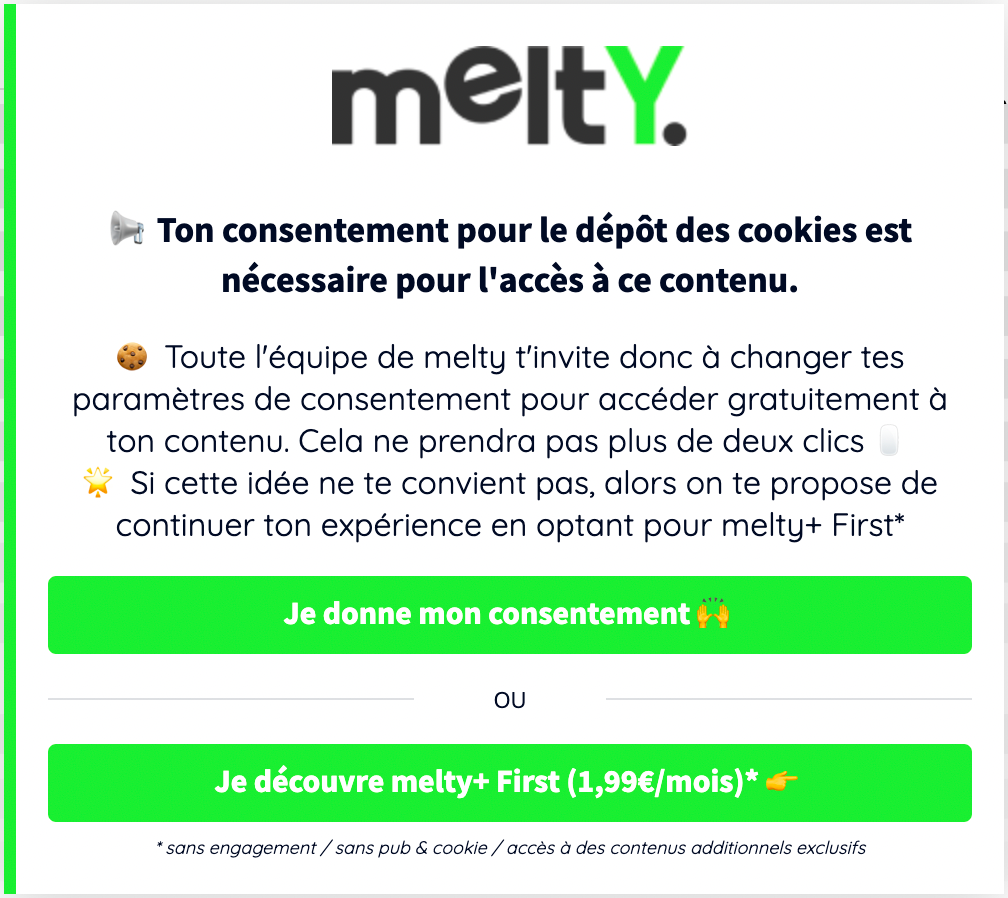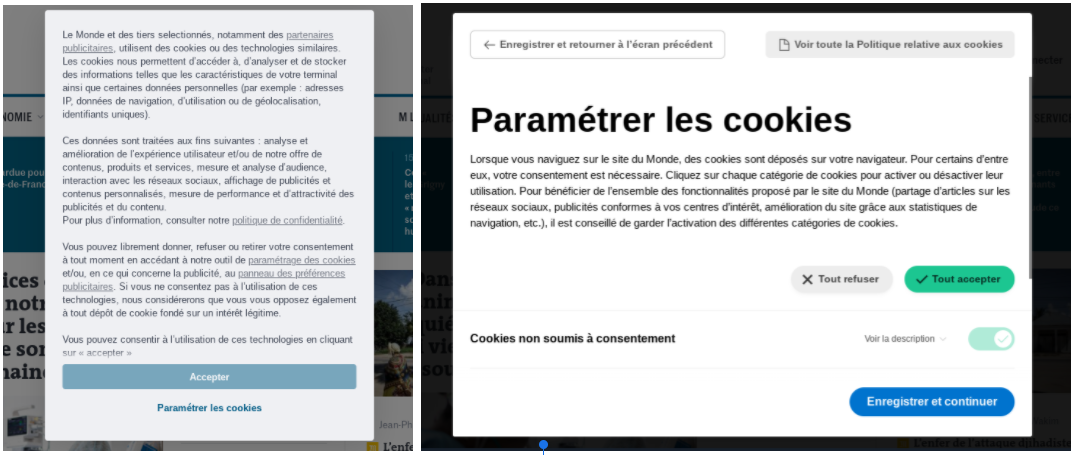Cookies are a pretty hot topic at the moment, and with companies being faced with constantly changing, ever tightening restrictions that differ around the world, it's hard to keep up.
However, these cookies are essential to the monetization strategies of many online businesses, particularly digital content producers who employ cookies for data collection and advertising revenue. These tightening cookie regulations are therefore making life a lot tougher for publishers, especially the legislations that make rejecting cookies even easier than ever.
This is where a Cookie Wall with an Alternative can prove hugely valuable. But what is a Cookie Wall with alternative? What are the legal requirements (such as GDPR) around collecting cookies? And how can publishers use a Cookie Wall to increase ARPU?
What is a Cookie Wall with Alternative?
A Cookie Wall with Alternative is presented to users who decline cookie collection when presented with the consent banner upon arriving on a site. This wall blocks content and asks the user to either accept cookies or choose another, cookie-free way of accessing content that supports the publisher in another way, such as by subscribing.

nice-matin employ the Didomi CMP (Consent Management Platform) to ask for consent to cookies, followed by Poool's Cookie Wall with alternate asking users to accept cookies to read content for free, or pay to subscribe.
A cookie wall alternative works in the same way as a paywall or registration wall, blocking content and asking for a value exchange. If a user rejects cookies on the cookie banner, a wall will ask a user to pick between two options:
- Accept cookies
- An alternative compensation choice, such as paying to subscribe or registering
This wall highlights the importance of cookies and tracking for publishers. They are essential to the monetization strategies of many content producers and help them to collect valuable first party data. Integrating a cookie wall alternative into your website will therefore provide a user with another chance to accept or the opportunity to help you in some other way.
Note that cookie walls (or any walls in fact) can be used by all online content-producers, from e-learning platforms and broadcasters to brands and social media sites. In short, walls are helping to solve the ever-growing monetization issues with online content producing, gaining publishers more users, subscribers, first party data and more. Take a look at some of our other articles on paywalls and registration walls for more wall-related information.
What are the laws surrounding cookie usage and Cookie Walls?
It goes without saying that you need to respect the law when using cookies. Unfortunately, it’s not as simple as that and restrictions differ around the world. To give a brief idea, we’ll look at the cookie and cookie wall laws in the EU compared to those in the US (note that these laws are constantly changing, so be sure to check the current requirements and keep up-to-date with alterations - this information is relevant in April 2021).
Using cookies:
Within the EU: Strict restrictions are placed on businesses and websites by the European Data Protection Board (EDPB), with 2 key laws in place relating to cookies - ePD (ePrivacy Directive) and GDPR (General Data Protection Regulation). These state that a website must tell users if cookies are used as well as clearly explain what they do and why. The user must give clear and active consent to cookie usage, except in the case of essential cookies for providing an online service. Have a look at these guidelines for more detailed information.

On the Poool website, for instance, you'll be told about the cookies we use and offered the choice of accepting, configuring cookie settings or refusing.
In the United States: Comparatively to Europe, privacy laws in America are very weak and there aren’t a huge number of restrictions in place. In short, you aren’t required to ask for consent when using cookies.
Cookie walls:
Within the EU: There aren’t many requirements surrounding cookie walls (aside from everything cookie-related). Note though that this is likely due to cookie walls being a fairly new concept and we’re expecting more regulations to be brought into effect in the coming months/years. France’s CNIL (National Commission on Informatics and Liberty), however, is slightly ahead of the game here. Although the CNIL discouraged cookie walls in 2019, they went back on this decision in 2020 stating that walls can only be used if they don’t hinder the user’s freedom to decline consent. I.e. users must always be offered a cookie-free option. This means that cookie wall alternatives are allowed but cookie walls aren't.
‘Allociné’ presents visitors with a cookie wall alternative as soon as they enter the site, offering a choice: consent or pay for cookie-free access. Although the paid option doesn’t include ad-cookies, it’s unclear what other cookie types are being used. This is important as readers need to be clearly informed of ALL cookies and tracking used.
In the US: No laws specific to cookie wall use.
Why are Cookie Walls and alternatives needed?
So, now you know what a cookie is, but why are cookie walls important to publishers?
As we’ve seen in the cookie-related laws, users are becoming increasingly in control of their privacy online, which is hugely important and great news for anyone who uses the internet (so, basically everyone). In France, for example, from April 2021, it’s even easier for users to reject cookies thanks to the requirement of a standard ‘refuse cookies’ option (take a look at the CNIL for more information).
Circled here is a new option on the cookie banner which makes refusing non-essential cookies even easier in France.
However, this means that a larger percentage of viewers will reject cookies, significantly reducing publisher’s revenue sources. Content producers are already battling against the loss of print revenue, so the rejection of cookies puts yet more pressure on them to continue to monetize.
This is where a cookie wall alternative can help. It allows publishers to manage the users who reject cookies, offering them a fair compensation choice to finance the content that they have access to. A cookie wall alternative is completely legal and abides by the regulations set in the EU if users are still given the option between cookies or not.
What do Cookie Wall Alternatives look like?
A cookie wall alternative will present the user with 2 or more options. One of these will be to accept cookies and tracking, whilst the other(s) can be anything from subscribing to paying a fee (in fact any compensation choice that is approved under cookie laws). Here’s an example of a wall that gives a visitor the option between giving consent or paying to subscribe.

This wall could be shown to a user (who has declined cookie usage) on the page they’re on, halfway through content or when trying to access a certain part of your site.
As with paywalls and registration walls, various types of cookie walls exist. The one chosen depends not only on the publisher and what form of wall they prefer, but also on the privacy laws in the country that their audience is in. For example, a hard cookie wall that only gives access to content to users who accept cookies wouldn’t be legal in the EU (as there’s no freedom of choice between cookies or not). According to the EDPB, access to content must not be conditional on a user’s consent of cookies. However, other approaches are legal in Europe and can benefit publishers hugely.
Freemium cookie wall alternative approaches will allow a user who has declined cookies to continue to access content, but often continually presents them with walls and messages to encourage them to change their mind.
Le Monde, a French publisher, brings up a cookie wall alternative if a visitor doesn’t accept their cookies and tracking.

Here you can see the user journey when they arrive on the site and decline cookies. In doing this, they activate the wall.
Le Monde doesn’t block a reader entirely if cookies are rejected as this wouldn’t comply with EU privacy laws. Instead, a yellow banner sits at the bottom of the page unless the reader either accepts cookies or subscribes/signs-in. One positive of Le Monde’s wall is that it explains why cookies are used and allows visitors to continue to read content without needing to accept. However, the yellow banner takes up a large part of the page, particularly on mobile devices where it covers more than half of the screen, making reading articles very difficult.
The Washington Post takes a hard cookie wall alternative approach, requiring a user to either continue to read for free with cookies or pay to subscribe. Fitting with new EU laws, the WP has now altered their subscription offer to be cookie-free, ensuring the user always has a choice between cookies or not.
Although they don’t use a cookie wall, The Guardian is an interesting publisher to look at here. In keeping with their friendly and pro-free news approach, if a user declines cookies they are presented with a message explaining how accepting cookies can help The Guardian to continue to provide a free service.
As we’ll discuss later, explaining how cookies can help content-creators without a user needing to pay is a great way to encourage acceptance of cookies.
A cookie wall could also become part of a larger chain of walls that lead a visitor to becoming a registered user and possibly a paying subscriber. A cookie wall is therefore just the tip of iceberg when it comes to walls, all of which can help you to reach your goals, whether that be monetization, improving engagement or increasing the number of registered users.
At Poool, we have created a dynamic wall that allows you to configure each step in the user journey using our many widget options. It is dynamic in the sense that you can segment your audience based on a certain criterion (e.g. propensity to subscribe, what device they’re using) and create a different journey for each user segment. This means that each reader will be presented with the most optimal journey for their profile.
What’s more, we’re excited to announce that we’ve collaborated with Didomi to integrate a ‘Cookie Wall Alternative’ as one of our widget options! This allows you to design two options on the wall, consent or another compensation choice (such as subscribe to a newsletter, watch an ad, register as a user). The scenario can also change based on the country that the user is in, meaning full and adapted compliance with restrictions around privacy and cookies. The best bit? We have free demo for you to see our solution in action! Book now!
Why is a Cookie Wall useful for publishers?
The important bit. Why should you employ a cookie wall alternative? There are a plethora of benefits of using a wall, for both the content-creator and their users.
- Cookies are valuable to you: A lot lies on your user’s accepting cookies and tracking. For starters, they are vital in many publishers’ monetization strategies, especially for those who rely on revenue from advertising. This means that encouraging users to accept cookies is essential to the success of an online publisher. What’s more, cookies help to understand user behavior (through analytics, testing, targeted advertising, to name a few) which is useful to all areas of business. Given their value, you want to give your user as many chances as possible to accept cookie usage, which is what a cookie wall ultimately does. It also offers a visitor another way to support you as a publisher, such as by paying to subscribe.
Buzzfeed’s cookie banner explains how cookies benefit them as well as the user.
- Opportunity to start a real dialogue with readers: Transparency and communication can go a long way in building a trusting relationship with your readers. If they feel fully in control of their privacy and data then they will be much more likely to return and become a loyal user. You’ll also have more visitors accepting cookies if you explain to them how this helps you to continue to produce content (i.e. how cookies are a form of value exchange), so explaining this on the cookie banner and/or wall is vital.
- Monetize and/or gain in other ways: A cookie wall alternative makes a reader either accept cookies or take another action of your choosing. If they accept cookies, you learn more about their behavior (extremely valuable) and can improve their experience which ultimately helps to make them more likely to return. If they choose the other option, you could potentially turn them into a paying subscriber, and so monetize from them, or a registered user, which benefits you in other ways (see here). Alternatively, you ask them to fill out a form (where you’ll learn something from them) or watch an ad (monetize from advertising). The options are pretty endless and you can adapt the wall to your brand and goals.
- Help spread the truth about cookies: Cookies have been given a bad rep over recent years and a fear has grown around how they are used. However, they can hugely improve the user experience as well as indirectly benefit publishers. So, let’s tell users. Just as The Guardian does in their cookie banner, we can inform visitors about how cookies can benefit us and them as well as explain to them that they can manage cookie usage whenever they want (and so have full control over how they’re used).
Cookies are also very important for the user and their experience on a website. They help to make our time online easier and more personalized as well as give publishers valuable information about our behavior which can be used to improve their site. This is a huge advantage for users and should be highlighted in your cookie banner or wall in order to persuade a visitor that cookies are worth accepting.
Not sure where to start? Poool can help! With an easy-to-integrate and personalizable wall solution, you can continue to monetize from advertising by encouraging readers to accept cookies. Book your free demo now!
If you’re interested in other types of walls, we also have articles on our blog covering paywalls and registration walls. Read about what they are, what types exist and some examples of each as well as how they can benefit you as a content-producer.
What are the best practices for Cookie Wall use?
To finish off, how about some top tips to ensure you make the most out of a cookie wall alternative.
- Tell readers why you collect cookies and which you collect: I think we’ve said this enough to make it clear that it’s important. Cookies can benefit publishers without readers having to pay. Help them understand what they are, how you use them and how it can benefit both parties. Most importantly, this is a legal requirement within the EU.
The BBC has written articles specific to cookies and privacy which are shown to anyone who goes on the ‘cookie settings’ page of their site.
- Give fair options: This is also an EU legal requirement – ‘consent can only be an appropriate lawful basis if a data subject is offered control and is offered a genuine choice with regard to accepting or declining the terms offered or declining them without detriment’ (from EDPB). I.e. a cookie-free option has to be something that the reader could actually consider, so not for them to pay $1000 (as an exaggerated example)!
- Personalize messages and optimize wording: You have one chance to persuade a user to make a certain decision, so make it count. Make the text concise, informative and choose words that serve your aim. As an added plus, a dynamic wall allows you to create different messages for each user segment, meaning the text can be optimized to match the type of reader that it's being shown to. On Poool’s dashboard, you can do exactly that as well as design the wall to perfectly fit into your brand style (you can find some examples of Poool’s design options here). Test our demo for free to play around with our publisher dashboard and all it has to offer.
- Respect the law: Obviously. Ensure you’re a law abiding content-producer in every country that your website operates in. Keep up to date with these (as they can change fairly regularly) and take care with how you use cookies and tracking, making sure you respect not only the law, but also your users and their data.
Want to chat more about our dynamic cookie wall solution (or another type of wall)? Book a meeting and free demo with one of our team now!

